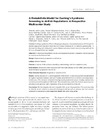Please use this identifier to cite or link to this item:
https://accedacris.ulpgc.es/jspui/handle/10553/42242
| Title: | A probabilistic model for cushing's syndrome screening in at-risk populations: a prospective multicenter study | Authors: | León-Justel, Antonio Madrazo-Atutxa, Ainara Alvarez-Rios, Ana I. Infantes-Fontán, Rocio Garcia-Arnés, Juan A. Lillo-Muñoz, Juan A. Aulinas, Anna Urgell-Rull, Eulàlia Boronat, Mauro Sánchez-De-Abajo, Ana Fajardo-Montañana, Carmen Ortuño-Alonso, Mario Salinas-Vert, Isabel Granada, María L. Cano, David A. Leal-Cerro, Alfonso |
UNESCO Clasification: | 3205 Medicina interna 320502 Endocrinología |
Keywords: | Cushing’s syndrome | Issue Date: | 2016 | Journal: | Journal of Clinical Endocrinology and Metabolism | Abstract: | Context: Cushing's syndrome (CS) is challenging to diagnose. Increased prevalence of CS in specific patient populations has been reported, but routine screening for CS remains questionable. To decrease the diagnostic delay and improve disease outcomes, simple new screening methods for CS in at-risk populations are needed. Objective: To develop and validate a simple scoring system to predict CS based on clinical signs and an easy-to-use biochemical test. Design: Observational, prospective, multicenter. Setting: Referral hospital. Patients: A cohort of 353 patients attending endocrinology units for outpatient visits. Interventions: All patients were evaluated with late-night salivary cortisol (LNSC) and a low-dose dexamethasone suppression test for CS. Main Outcome Measures: Diagnosis or exclusion of CS. Results: Twenty-six cases of CS were diagnosed in the cohort. A risk scoring system was developed by logistic regression analysis, and cutoff values were derived from a receiver operating characteristic curve. This risk score included clinical signs and symptoms (muscular atrophy, osteoporosis, and dorsocervical fat pad) and LNSC levels. The estimated area under the receiver operating characteristic curve was 0.93, with a sensitivity of 96.2% and specificity of 82.9%. Conclusions: We developed a risk score to predict CS in an at-risk population. This score may help to identify at-risk patients in non-endocrinological settings such as primary care, but external validation is warranted. | URI: | https://accedacris.ulpgc.es/handle/10553/42242 | ISSN: | 0021-972X | DOI: | 10.1210/jc.2016-1673 | Source: | Journal of Clinical Endocrinology and Metabolism[ISSN 0021-972X],v. 101, p. 3747-3754 |
| Appears in Collections: | Artículos |
SCOPUSTM
Citations
36
checked on Jun 8, 2025
WEB OF SCIENCETM
Citations
34
checked on Jun 8, 2025
Page view(s)
95
checked on Apr 6, 2024
Download(s)
187
checked on Apr 6, 2024
Google ScholarTM
Check
Altmetric
Share
Export metadata
Items in accedaCRIS are protected by copyright, with all rights reserved, unless otherwise indicated.

